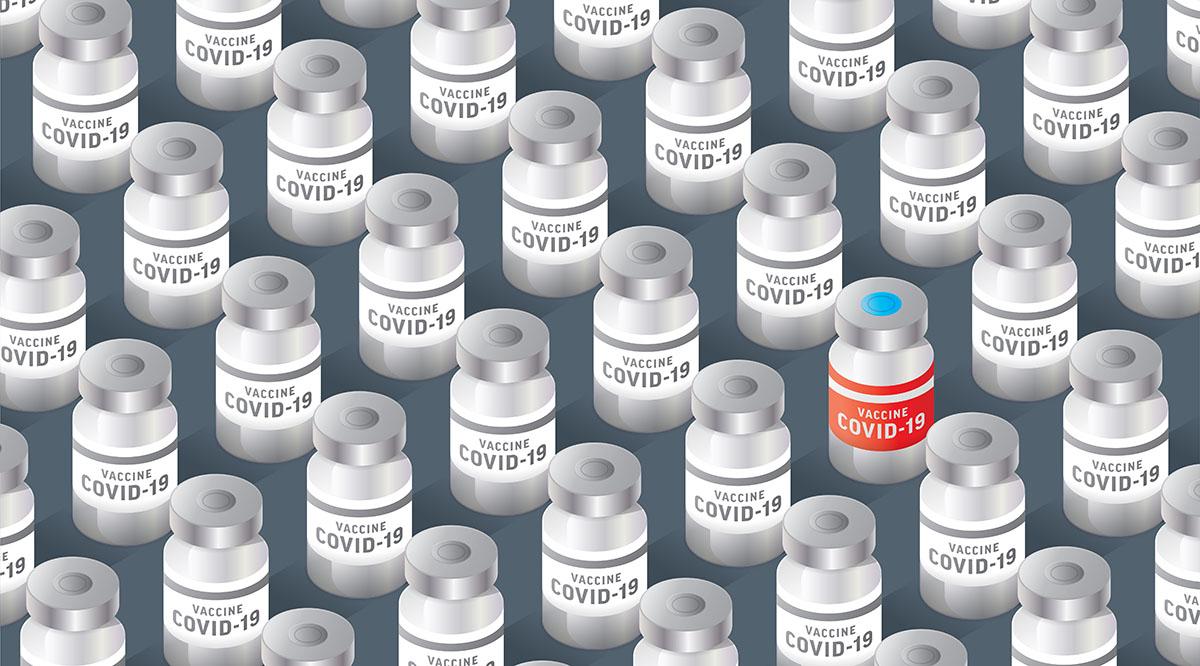Despite a pause in the administration of the Johnson & Johnson COVID-19 vaccine on April 13, the pace of vaccinations in the United States has been increasing rapidly, with more than 3 million people receiving a shot each day since early April. At that rate, most experts expect the United States to reach some level of herd immunity by the summer. The two outstanding variables? Increasingly contagious virus variants — particularly the B.1.1.7 variant that was first identified in the United Kingdom and is now the dominant strain in the United States — and a declining but still substantial proportion of the population that refuses to get a vaccine.
AAMCNews talked to experts throughout academic medicine to find out what we know and don’t know about herd immunity; how soon we are likely to reach that elusive goal, if ever; and how to overcome the barriers that stand in the way.
What is herd immunity?
Herd immunity occurs when a significant portion of a population achieves immunity to a disease, either through prior infection or vaccination, so that the disease is unable to spread from person to person. The percentage of the population that must have immunity in order to achieve that goal varies depending on how contagious the disease is.
For instance, measles is highly contagious — so much so that 95% of the population must be immunized in order to stamp out the disease, according to the World Health Organization. For polio, the figure is 80%.
Since COVID-19 is a brand-new disease, no one quite knows what level of immunity might be required to stop SARS-CoV-2 from spreading. National Institute of Allergy and Infectious Diseases Director Anthony Fauci, MD, recently stated that he thinks that 70% to 85% of the population might need to be immune before the coronavirus is effectively contained.
Alessandro Sette, Dr.Biol.Sci, an immunologist at the La Jolla Institute for Immunology in California whose lab has conducted extensive research into the immune response to the virus, agrees. “I would say 85% is a reasonable point of view and a goal to shoot for,” he says. “And then we would be pleased if it turns out that getting infections down is reached before that.”
Where we stand now
The U.S. population stands at about 330 million, according to the latest U.S. census figures. Assuming that Fauci and Sette are correct, between 230 million and 280 million people would need to be immune before the pandemic can be stopped.
So where are we now?
Immunity from natural infection: The Centers for Disease Control and Prevention’s (CDC’s) COVID Data Tracker shows that about 31.5 million people in the United States have been infected with the coronavirus since February 2020. But those are the official, confirmed numbers. Most experts say that because of inadequate testing and reporting, the true number of infections is many times higher — the CDC put this number at 83 million by December 2020.
Eric Topol, MD, the founder and director of the Scripps Research Translational Institute in La Jolla, estimates that the number of actual infections is close to 100 million. “It could be as high as 110 million or it could be 90 million, but the serology tests — the good ones — say that we’ve confirmed less than a third of infections,” he explains.
Those 100 million people do have some level of immunity against reinfection, says Sette. A study from his lab published earlier this year in Science found that prior infection with the coronavirus conveys robust immunity for at least eight months — and likely much longer. And while much is unknown about how well natural infection protects against the variants, Sette notes that preliminary data show that “natural infection does give some degree of protection” against most of the variants. (The jury is still out on how well natural infection protects against the P.1 variant first identified in Brazil, he says.)
Immunity from vaccination: In addition to the roughly 100 million U.S. residents who have gained natural immunity, about 132 million (about 40% of the population) have received at least the first shot of a coronavirus vaccine, including 80% of those age 65 and older.
Even one shot conveys broad immunity — a recent CDC study showed that one dose of the Pfizer or Moderna vaccine was 80% effective in preventing infections two weeks after the first dose.
Overlap between the two groups: While no one knows for certain how many people who were previously infected have received a vaccine, Topol estimates that about half of the 100 million U.S. residents previously infected with SARS-CoV-2 have been vaccinated. “That puts us at about 50 million who had COVID and are not vaccinated,” he says.
That group of 50 million who are not vaccinated but have some level of natural immunity — plus the 132 million who have been vaccinated — gets us to about 182 million of the 230 million to 280 million needed to reach herd immunity.
What real-world data shows
Earlier this month, Texas Gov. Greg Abbott suggested that his state might have reached herd immunity, as hospitalizations and deaths have declined dramatically in Texas. But many experts say that’s to be expected since a good number of older residents are vaccinated. Truly stopping the pandemic will mean getting case numbers under control, though, and that will require vaccinating a significantly greater proportion of the population.
How much of the population must be vaccinated to reach herd immunity is becoming clearer, based on real-world data trickling in from other countries.
Israel, in particular, has outpaced every other country in vaccinating its population. On April 19, 60% of Israel’s population had received at least one dose of a vaccine. That same day, the country recorded just 151 new cases of the virus, despite easing public health restrictions. (In January, the country was recording 8,000 new cases a day.)
“It’s impossible to know what the magic threshold is for herd immunity” through vaccination, says Monica Gandhi, MD, MPH, a professor of medicine and associate division chief of the Division of HIV, Infectious Diseases, and Global Medicine at UCSF Zuckerberg San Francisco General Hospital and Trauma Center. “But if you look at Israel, which is the country that has vaccinated its population the fastest but is still testing a lot and is wide open, I’m very hopeful that that magic number is going to be somewhere between 60% and 70%.”
Another real-world example is the United Kingdom, Gandhi notes. On April 19, 49% of the population there had received at least one dose of a vaccine; the number of new cases that same day was 2,545. The United Kingdom started easing restrictions on April 12, including allowing larger in-person events without masks and distancing. (At its peak in January, the country was recording almost 60,000 new cases each day.)
Why we’re likely to have community-level immunity before population-level (herd) immunity
Herd immunity is the ultimate goal, but as more people are vaccinated, pockets of the United States might reach what Gandhi refers to as “community-level immunity,” where a combination of natural immunity and vaccinations keeps virus cases low in certain cities or states.
We’re not there yet — particularly in the Midwest and especially in Michigan, where infections have markedly increased, due in large part to the spread of the more contagious B.1.1.7 variant. “The hope is that this is a small wave,” Topol says. “The highest-risk people are now the most protected, whereas before, they were the most vulnerable.”
Indeed, even as case numbers have climbed in recent weeks, hospitalizations and deaths have declined — except in a few states, including Michigan, where hospitalizations are the highest they’ve been since April 2020.
Gandhi doesn’t believe that the infection rate needs to be zero before we can relax our guard, though. “I believe very strongly that we should not be going for a COVID-zero strategy,” she says. “Low levels of community transmission of infectious diseases have been tolerated for centuries.”
Can we contain the virus without vaccinating children — or convincing the vaccine-reluctant?
The question is how many more people need to be vaccinated before the United States sees the striking decline in case numbers experienced by Israel. If Gandhi’s 60% figure is accurate, that equates to an additional 66 million more residents who need to be vaccinated; if it’s 70%, then 100 million more need to step up for vaccination.
Some, of course, are not yet eligible — in particular, children younger than age 16. (Pfizer has shown that its vaccine is 100% safe and effective in children between the ages of 12 and 15 — and has applied for emergency use authorization [EUA] for that cohort.) Assuming that EUA is granted, that still leaves 49 million children under the age of 12 — about 15% of the U.S. population — who are not yet eligible for vaccination. “I do think we’re going to reach herd immunity without vaccinating younger children,” Gandhi says, citing a recent Israel-based study that shows for every 20-point increase in vaccinations among adults, the risk of transmission in younger children halves.
Notably, about 20% of the population has no plans to get a vaccine, with another 17% in a wait-and-see pattern, according to the Kaiser Family Foundation, which has been tracking public sentiment around COVID-19 vaccination. That includes large numbers of health care workers, but it also includes those who are younger and politically conservative.
And convincing at least some of them to be vaccinated will be necessary. Topol thinks more young people will be vaccinated when they are the ones being hospitalized — a trend that is already starting to play out in some states. “We’re going to get reports about younger people getting sick and being hospitalized and even dying. It’s awful, but it’s going to be one way that younger folks realize they’re not immortal.”
That happened in Israel, he says, and it was one catalyst that helped propel that country to population-level immunity. (Topol prefers that term to herd immunity.) “Israel has population-level immunity. We’ll get there. But it will take a good part of the next three months to get to or exceed where Israel is right now. The difference is we have 330 million people and they have 9 million.”
Gandhi is hopeful we’ll be able to reach some level of virus containment even sooner. “If I thought herd immunity had to happen at 90%, which we were thinking four months or even a week ago, I’d be more worried. But now that we see it’s not going to be that high, I’m not as worried,” she says.
But she does advocate for better messaging around vaccine uptake. “As someone who did a lot of research around masks, I couldn’t stand the messaging that said, ‘Wear a stupid mask,’” she says. “A lot of people who don’t want to get the vaccines are anti-mask. So, if they get the vaccine, the masks will go away. Let’s talk about that to generate confidence in the vaccines. Just like any public health message, we need to be gentle and try to meet people where they are.”

